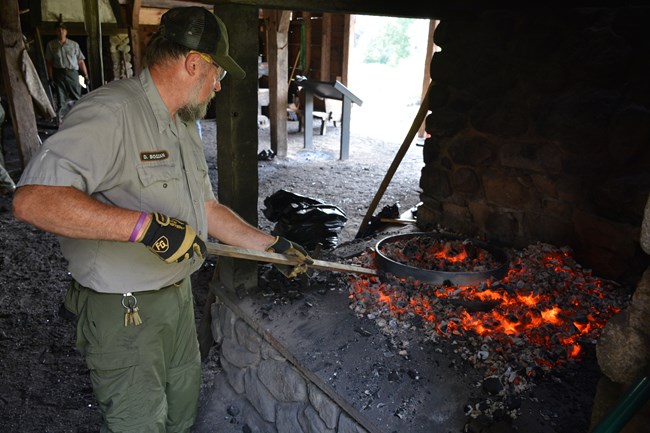Part of a series of articles titled Iron Making.
Previous: Iron Making: Casting
Article

NPS Photo / Maryann Zujewski
Workers in the forge converted brittle cast iron "pigs" and "sows" into malleable wrought iron by carefully removing excess carbon in two separate processes, fining and hammering.
Details regarding the original design of finery hearths have yet to be discovered. Typically, they were specially constructed with stone and lined with cast iron plates. It is possible that gray cast irons and white cast irons were both processed by positioning the iron plates and aiming the air draft from water-powered bellows. A charcoal fire built that was large enough to cover the end of a sow.
To refine cast iron into wrought iron, heavy pigs and sows were dragged from the furnace to the forge by oxen. They were positioned.in the finery hearth through an aperture in the side of the chimney. Rollers guided the sows into the fire where they were slowly melted. Long iron bars or "ringers" were used to manipulate the melted iron. The iron was melted iron was lifted up into the air blast over and over again until the carbon was sufficiently reduced. As the carbon content went down the melting temperature went up. Perhaps this was an indicator to the finer when the iron had reached the desired carbon content. The process produced more slag and it is possible that some slag may have been deliberately added to assist in the carbon reduction process.
The iron was removed from the finery hearth as a "loop". Excess charcoal was removed from the outside surface of the loop then the hammering began. The initial hammering was done with long-handled sledge hammers. Then it was dragged to the 500 pound helve-hammer for heavier blows.
Hammermen completed the wrought iron bars by forging them between the hammer and the anvil. The loop was hammered into a block or "bloom". From there the bloom was hammered systematically from its middle out towards one end. The bar would be re-heated numerous times in the "chafery hearth" to maintain a welding heat. The bar would be turned end-for-end in the tongs and the hammerman would draw out the other end of the bar, again from the middle, outwards.
In the loop stage, the iron was in the form of spongy mass of iron crystals with pockets of slag throughout. The hammering process welded and elongated the iron crystals. As in the blast furnace, slag acted as a flux to reduce oxidization while the iron was welded together. By working from the center outward, excess slag was squeezed to the ends of the bars. The result was the main product of the iron works, wrought iron merchant bars.
The majority of merchant bars were brought to the Saugus River for shipment to merchants or blacksmiths. Eventually it was the blacksmiths off site that would hammer the wrought iron into serviceable tools and hardware.
Part of a series of articles titled Iron Making.
Previous: Iron Making: Casting
Last updated: November 30, 2021